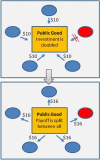An evolutionary perspective on the Crabtree effect
- PMID: 25988158
- PMCID: PMC4429655
- DOI: 10.3389/fmolb.2014.00017
An evolutionary perspective on the Crabtree effect
Abstract
The capability to ferment sugars into ethanol is a key metabolic trait of yeasts. Crabtree-positive yeasts use fermentation even in the presence of oxygen, where they could, in principle, rely on the respiration pathway. This is surprising because fermentation has a much lower ATP yield than respiration (2 ATP vs. approximately 18 ATP per glucose). While genetic events in the evolution of the Crabtree effect have been identified, the selective advantages provided by this trait remain controversial. In this review we analyse explanations for the emergence of the Crabtree effect from an evolutionary and game-theoretical perspective. We argue that an increased rate of ATP production is likely the most important factor behind the emergence of the Crabtree effect.
Keywords: Crabtree effect; evolution of metabolism; evolutionary game theory; respiro-fermentation; yeast energy metabolism.
Figures



References
-
- Berg J., Tymoczko J. L., Stryer L. (2002). Biochemistry, 5th Edn. New York, NY: W.H. Freeman.
-
- Cameron D. D., White A., Antonovics J. (2009). Parasite-grass-forb interactions and rock-paper- scissor dynamics: predicting the effects of the parasitic plant Rhinanthus minor on host plant communities. J. Ecol. 97, 1311–1319 10.1111/j.1365-2745.2009.01568.x - DOI
LinkOut - more resources
Full Text Sources
Other Literature Sources
Molecular Biology Databases

